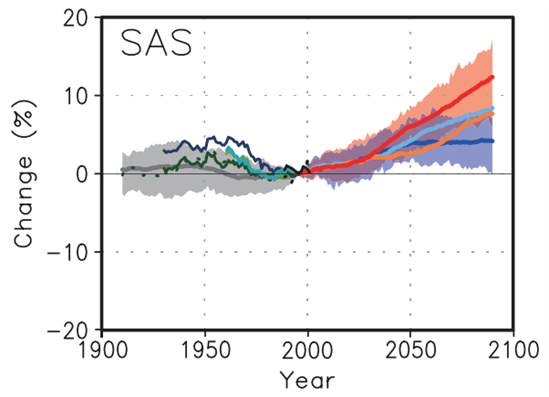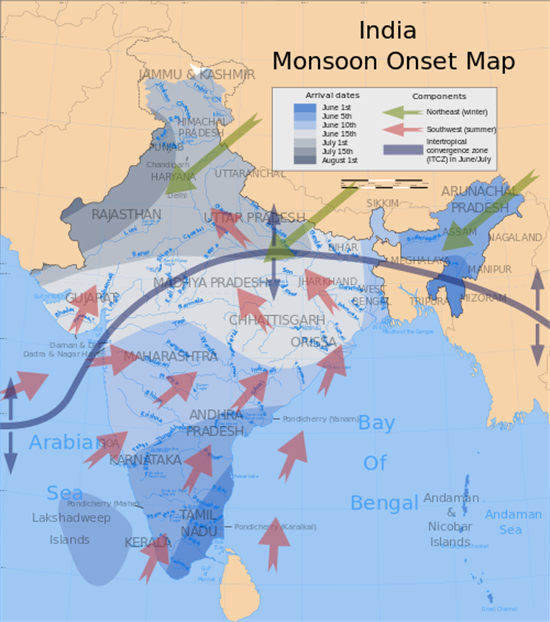Entering an era of bigger monsoons
Asian monsoon rains will intensify as carbon dioxide levels and temperatures increase. That's the prediction made by a new study, that also discovers the monsoon system has existed for at least 15 million years longer than previously thought.
Intense rainfall
The monsoon is the largest climate system in the world. It brings intense rainfall to much of mainland Asia and is the lifeblood of agriculture-reliant economies in the region. It can also bring devastating floods, as seen in Kashmir this week.
The research, published in Nature, found that the strength of monsoon rains has varied over the past 40 million years as the amount of carbon dioxide in the atmosphere has changed naturally.
The monsoon system emerged at a time when levels of carbon dioxide levels were three or four times what they are today, the researchers say. It then weakened as carbon dioxide levels gradually reduced and the Earth entered an ice age 34 million years ago.
The study reinforces what scientists already know – that there's a connection between the strength of the greenhouse effect and the Asian monsoon system. But as Dr Alexis Licht, lead author on the paper, tells us:
"This suggests that the monsoons may be more sensitive to global climate change than we thought."
The latest IPCC projections suggest an increase in both average and extreme rainfall in south Asia (see figure below) in all scenarios of future emissions. According to Licht, their research "supports the last IPCC report, predicting intensified monsoonal precipitation in Asia".
Figure 1: Past and projected future monsoon rainfall for southern Asia, as percentage changes from present day. (Different colour lines show different scenarios, with shading showing the range across the different climate models.)
Source: IPCC
Temperature contrast
The monsoon is driven by the difference in temperature between the Asian continent and adjoining oceans. Land warms and cools more quickly than water, creating pressure differences in the atmosphere, which causes winds to strengthen.
In summer, when the land is warmer than the sea, winds blow over the Indian ocean towards the land, bringing heavy rains to most of southern Asia from June to September (as shown in the figure below). The rains are most intense where the winds rise over mountains, such as in southwest India.
As the land cools into autumn, the winds reverse, bringing dry air over Asia for the winter.
Figure 2: Map showing the passage of the Asian monsoon over India. (Arrows show wind direction in summer {red} and winter {green}. Blue line illustrates the band of intense monsoon rains.)
Source:.Saravask, based on work by Planemad and Nichalp
Climate model projections for monsoon rainfall show increases in the future for two reasons. First, because warming will be more rapid over land, increasing the temperature contrast with the oceans. And secondly, because a warmer atmosphere can hold more water vapour.
Projections also show that changes in the wind patterns will result in the monsoon starting earlier and finishing later.
Snail shells
Scientists had thought the Asian monsoon had started with the formation of the Himalayan mountains, between 22 and 25 million years ago.
As the Earth's landmasses shifted around, India moved north and collided into the rest of Europe and Asia. The land at the join between the two masses was forced upwards, forming the Himalayan mountains.
As air passes over these mountains it rises, causing water vapour in the air to condense and form clouds, which brings rain. Scientists had thought that the monsoon started once the Himalayas were there for the air to rise over.
But this new study suggests the monsoon was well established at least 15 millions years before the Himalayas formed. Scientists studied fossils of teeth from mammals and shells of freshwater snails found in Myanmar. By analysing the type of oxygen they contained, the scientists could establish whether they lived in periods of wet or dry conditions. What they found was evidence of a monsoon system in the pattern of wet summers and dry winters.
The findings reveal that the monsoon system was around in some form long before the Himalayas were formed. As Licht tells us:
"It shows that global events (such as global warming or cooling) have a similar – and most probably stronger – impact as regional topography on monsoonal intensity."
The implications of their analysis are that as greenhouse gas concentrations in the atmosphere increase, and with it global temperatures, the Asian monsoon is likely to become more intense through the 21st century.
Originally published by Carbon Brief. Reproduced with permission.


















